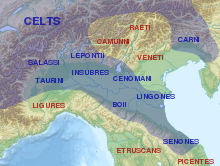| Comune | Inhabitants (2006) | Area (km2) | Administrative Subdivisions |
| Amaro (Damâr) | 811 | 33.26 | - |
| Ampezzo (Dimpeç) | 1,089 | 73.61 | Oltris, Voltois |
| Arta Terme (Darte) | 2,287 | 52.24 | Avosacco, Cabia, Cedarchis, Lovea, Piano d'Arta, Piedim, Rivalpo, Valle |
| Cavazzo Carnico (Cjavaç) | 1,108 | 38.69 | Cesclans, Mena, Somplago |
| Cercivento (Çurçuvint) | 748 | 15.36 | Cercivento di Sotto, Cercivento di Sopra |
| Comeglians (Comelians, loc. Comalians) | 603 | 19.52 | Calgaretto, Maranzanis, Mieli, Noiaretto, Povolaro, Runchia, Tualis |
| Enemonzo (Enemonç) | 1,389 | 23.70 | Colza, Esemon di Sotto, Fresis, Maiaso, Quinis, Tartinis |
| Forni Avoltri (For di Avoltri, loc. Fôr Davuatri) | 681 | 80.71 | Collina, Collinetta, Frassenetto, Sigilletto |
| Forni di Sopra (Fôr Disore) | 1,087 | 81.16 | Andrazza, Cella, Vico |
| Forni di Sotto (Fôr Disot) | 701 | 93.54 | Tredolo, Baselia, Vico |
| Lauco (Lauc) | 819 | 34.58 | Allegnidis, Avaglio, Buttea, Chiassis, Trava, Vinaio |
| Ovaro (Davâr) | 2,126 | 57.88 | Agrons, Cella, Chialina, Clavais, Cludinico, Entrampo, Lenzone, Liariis, Luincis, Luint, Mione, Muina, Ovasta |
| Paluzza (Paluce) | 2,494 | 69.96 | Casteons, Cleulis, Rivo, Timau |
| Paularo (Paulâr, locally Dincjaroi) | 2,855 | 84.23 | Casaso, Chiaulis, Dierico, Misincinis, Ravinis, Rio, Salino, Trelli, Villafuori, Villamezzo |
| Prato Carnico (Prât) | 1,007 | 81.48 | Avausa, Croce, Osais, Pesariis, Pieria, Pradumbli, Prico, Sostasio, Truia |
| Preone (Preon) | 297 | 22.51 | - |
| Ravascletto (Ravasclêt, locally Monai) | 596 | 26.32 | Salars, Zovello |
| Raveo (Raviei) | 480 | 12.63 | Esemon di Sopra |
| Rigolato (Rigulât) | 579 | 30.47 | Givigliana, Gracco, Ludaria, Magnanins, Stalis, Tors, Valpicetto, Vuezzis |
| Sauris (Zahre, in the local German dialect) | 427 | 41.52 | La Màina, Latéis, Sàuris di Sotto, Sàuris di Sopra, Velt |
| Socchieve (Soclêf) | 950 | 65.95 | Caprizzi, Dilignìdis, Feltrone, Lungis, Mediis, Nonta, Priuso, Viaso |
| Sutrio (Sudri) | 1,393 | 21.06 | Nojaris, Priola |
| Treppo Ligosullo (Trep and Liussûl) | 715 | 35.59 | Gleris, Murzalis, Siaio, Tausia, Zenodis |
| Verzegnis (loc. Verzegnas) | 924 | 38.80 | Chiaicis, Chiaulis, Intissans, Villa |
| Villa Santina (Vile) | 2,234 | 13.00 | Invillino |
| Zuglio (Zui) | 633 | 8.31 | Fielis, Formeaso, Sezza |
| | | |
| Tolmezzo (Tumieç) | 10,539 | 65.69 | Cadunea, Caneva, Casanova, Cazzaso, Fusea, Illegio, Imponzo, Terzo |
| | | |
| Total | 39,705 | 1,221.64 | 124 |








